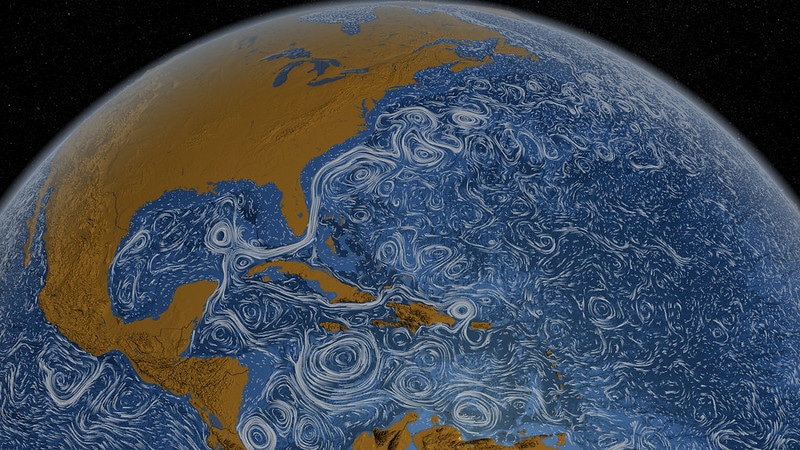According to a 2021 paper published in the scientific journal Nature Geoscience, the Atlantic Gulf Stream, a major climate-regulating oceanic current that plays a crucial role in redistributing heat throughout the Earth’s climate system, is now at its weakest in over 1,600 years. The cause? Increasingly warm global temperatures are directly related to the impact of human-induced climate change, a phenomenon that has already been long predicted by climate scientists. What does this slowdown of the Atlantic Ocean circulation mean for the future of our climate and how can we reverse this?
—
The findings are the latest setback in an already mounting global climate crisis, with experts worrying that the slowdown in ocean current circulation could further aggravate the adverse effects of climate change, from rising sea levels in the East Coast of the United States to an increase in extreme weather conditions in Europe, North America and North Africa such as heatwaves, drought, intense winter storms, and severe flooding.
The Gulf Stream, also known as the Atlantic Meridional Overturning Circulation (AMOC), is a large circulation of ocean currents transporting warm water from the tropics into the North Atlantic Ocean. The system is part of a global pattern called thermohaline circulation, or what scientists refer to as the “great ocean conveyor belt,” a constantly moving system of deep-ocean water driven by differences in temperature and salinity.
You might also like: Does an Island Lose its Statehood if it Sinks?
This natural process of global ocean current circulation helps ensure the Earth’s oceans remain continually mixed and that heat and energy are evenly distributed, which, in turn, directly affect the climate humans live in today. Without this constant flow of current circulation, regional temperatures would become more extreme – intense heat near the equator and freezing in the poles – making less land on Earth habitable.
Several climate models have indicated the AMOC may further weaken over the course of this century as greenhouse gas emissions continue to climb. A weakening AMOC can cause a decrease in the ocean’s effectiveness in absorbing atmospheric carbon dioxide, leading to a higher amount of greenhouse gasses in the atmosphere. Scientists warn that should increasing temperatures persist, the AMOC could reduce by at least 34% to 45% and reach a critical “breaking point” by the year 2100, at which the circulation system could become “permanently unstable.”
However, new studies have shown that one particular phenomenon could help delay the recent slowdown of current circulation in the Atlantic Ocean.
According to researchers from the Scripps Institution of Oceanography at the University of California San Diego, rising warm temperatures in the Indian Ocean can help stall the slowdown of ocean circulation and re-strengthen the AMOC. Such warming in the Indian Ocean can produce additional precipitation, which, consequently, extracts more air from other regions of the world, including the Atlantic Ocean.
The amount of precipitation in the Indian Ocean will subsequently result in less precipitation in the Atlantic, leading to higher levels of water salinity within the tropical areas of the ocean. This saline water, which travels north through the AMOC, will turn cold and sink at a faster rate than normal, kickstarting an intensification in current circulation in the Atlantic Ocean.
This intensification of ocean circulation would then have a direct impact on climate in nearby regions such as Europe, where the heat carried northwards helps keep the Atlantic Ocean warmer during the winter, warming surrounding countries as a result. If ocean currents were to come to a complete stop, however, Europe’s average temperature may cool by a staggering 5 to 10 degrees Celsius.
Still, if the warming of other major tropical oceans, including the Pacific, overtakes that of the Atlantic, this intensification in circulation for the AMOC may decrease altogether.
While a complete dissolution of the AMOC system is highly unlikely, the further slowdown of ocean current circulation is likely to continue. Given this uncertain future, monitoring existing global ocean circulation patterns remains a key aspect in tackling climate change. Numerical models are essential tools in studying ocean circulation, but observations through long-term measurements of precise circulation strength are heavily needed.
In addition, greater research into the potential weather impacts of an AMOC slowdown and its associated sea surface temperature patterns must be carried out. Climate scientists may have pointed out the Atlantic’s AMOC “will not collapse anytime soon”, but its continuing slowdown is something that definitely should not be taken lightly in the ongoing global push for greater climate action.
Featured image: NASA Goddard Space Flight Center/Flickr
You might also like: Global Warming Could Push Atlantic Past a Tipping Point by Mid-Century Under Current Emissions Scenario: Study

















